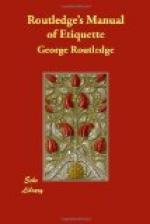This pretty though now somewhat old-fashioned dance was, before the introduction of the Deux Temps and Polka, a principal feature in every ball-room. It is danced with the step and music of the Old Valse a Trois Temps, played slower than the music of the Deux Temps.
Sometimes the couples stand in two long parallel lines, as in a country dance; sometimes they are arranged in a circle. The leading gentleman must be on the ladies’ side, and his partner on the gentleman’s side. Every fourth lady and gentleman exchange places, to avoid the necessity of keeping the other couples waiting. The whole set can thus begin at the same moment.
Leading gentleman and second lady advance and retreat with Valse step, and change places. Leading lady and second gentleman do the same at the same time.
Leading gentleman and his partner advance and retreat, and change places. Second lady and gentleman do the same at same time. Leading gentleman and second lady repeat this figure; first lady and second gentleman likewise, at same time.
Leading gentleman and first lady repeat same figure; second gentleman and lady repeat at same time.
All four, joining hands, advance to centre, and retreat. Ladies pass to the left. Repeat three times. Each gentleman takes his partner, and the two couples valse round each other once or twice at pleasure; the second lady and gentleman being left at the top of the figure, as in a country dance. Leading gentleman and partner repeat same figure with succeeding couple to end of dance.
It is obvious that there must be an equal number of couples; and that they must be arranged in sets of four, eight, sixteen, twenty, twenty-four, and so on.
* * * * *
XXIII.—LA TEMPETE.
La Tempete was brought over to this country from Paris some years ago. It speedily became a favourite, and for several seasons was much danced in London and the provinces. It unites the cheerfulness of the quadrille with the sociability of the country dance; and when its lively figures are correctly performed, it is both amusing and animated.
It is divided into parties of four couples, like the quadrille; but their arrangement is different. Two couples stand side by side, facing their respective vis-a-vis; there are not any side couples. As many sets of four couples can be thus arranged as the room will accommodate. Each new set turns its back upon the second line of the preceding set. Thus the dance can be the whole length of the room, but is only the breadth of two couples. The figure is as follows:—
Place two couples side by side, the lady standing at the right hand of the gentleman. Place two other couples as their vis-a-vis. Next place two couples with their backs turned to the first set; two couples opposite them for their vis-a-vis; and continue arranging more sets of four couples according to the number of the dancers and the size of the room.




